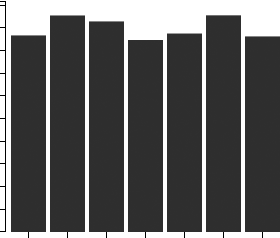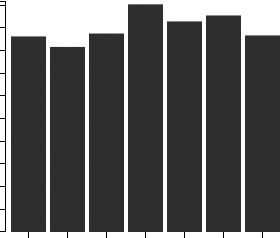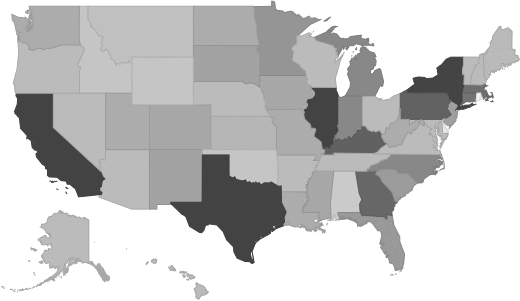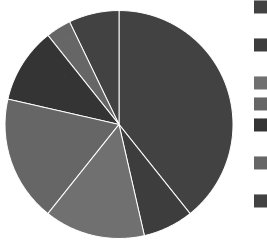Music Publishers Industry - Market Research Report
Industry Overview
This industry comprises establishments primarily engaged in acquiring and registering copyrights for musical compositions in accordance with law and promoting and authorizing the use of these compositions in recordings, radio, television, motion pictures, live performances, print, or other media. Establishments in this industry represent the interests of the songwriter or other owners of musical compositions to produce revenues from the use of such works, generally through licensing agreements. These establishments may own the copyright or act as administrator of the music copyrights on behalf of copyright owners. Publishers of music books and sheet music are included in this industry.
Source: U.S. Census BureauMarket Size and Industry Forecast
This research report analyzes the market size and trends in the Music Publishers industry. It shows overall market size from 2020 to the present, and predicts industry growth through 2030. Revenues data include both public and private companies.
| Historical | Forecasted |
|---|
| 2020 | 2021 | 2022 | 2023 | 2024 | 2025 | 2026 | 2027 | 2028 | 2029 | 2030 |
|---|
| Market Size (Total Revenue) | Included in Report |
| % Growth Rate |
| Number of Companies |
| Total Employees |
| Average Revenue per Company |
| Average Employees per Company |
Source: U.S. government financial dataIndustry Revenue ($ Billions)

Industry Forecast ($ Billions)

Advanced econometric models forecast five years of industry growth based on short- and long-term trend analysis. Market size includes revenue generated from all products and services sold within the industry.
Geographic Breakdown by U.S. State
Market size by state reveals local opportunity through the number of companies located in the region. Each state's growth rate is affected by regional economic conditions. Data by state can be used to pinpoint profitable and nonprofitable locations for Music Publishers companies in the United States.
Music Publishers Revenue by State

Distribution by Company Size
| Company Size | All Industries | Music Publishers |
|---|
| Small Business (< 5 Employees) | Included |
| Small Business (5 - 20) |
| Midsized Business (20 - 100) |
| Large Business (100 - 500) |
| Enterprise (> 500) |
Music Publishers Industry Income Statement (Average Financial Metrics)
Financial statement analysis determines averages for the following industry forces:
- Cost of goods sold
- Compensation of officers
- Salaries and wages
- Employee benefit programs
- Rent paid
- Advertising and marketing budgets
The report includes a traditional income statement from an "average" company (both public and private companies are included).
| Industry Average | Percent of Sales |
|---|
| Total Revenue | Included |
| Operating Revenue |
| Cost of Goods Sold (COGS) |
| Gross Profit |
| Operating Expenses |
| Operating Income |
| Non-Operating Income |
| Earnings Before Interest and Taxes (EBIT) |
| Interest Expense |
| Earnings Before Taxes |
| Income Tax |
| Net Profit |
Average Income Statement

Cost of Goods Sold
Salaries, Wages, and Benefits
Rent
Advertising
Depreciation and Amortization
Officer Compensation
Net Income
Financial Ratio Analysis
Financial ratios allow a company's performance to be compared against that of its peers.
| Financial Ratio | Industry Average |
|---|
| Profitability Ratios | Included |
| Profit Margin |
| ROE |
| ROA |
| Liquidity Ratios |
| Current Ratio |
| Quick Ratio |
| Activity Ratios |
| Average Collection Period |
| Asset Turnover Ratio |
| Receivables Turnover Ratio |
| Inventory Conversion Ratio |
Products and Services Mix
Product lines and services in the Music Publishers industry accounting for the largest revenue sources.
| Product Description | Description | Revenue
($ Millions) |
|---|
| Industry total | Included |
| Licensing of rights to use musical compositions |
| In broadcast performances (i.e., broadcast performance rights) |
| To reproduce & distribute recordings (i.e., mechanical rights) |
| Licensing of international rights to pub dom musical compositions |
| Print music |
| In television programs (i.e., television synchronization rights) |
| Print music - sheet music, folios, & electronic musical text |
| In other works |
| To record/reproduce for com use, ex for distr as phonorecords |
Salary information for employees working in the Music Publishers industry.
| Title | Percent of Workforce | Bottom Quartile | Average (Median) Salary | Upper Quartile |
|---|
| Management Occupations | 12% | Included |
| Top Executives | 5% |
| Chief Executives | 0% |
| General and Operations Managers | 5% |
| General and Operations Managers | 5% |
| Business and Financial Operations Occupations | 12% |
| Business Operations Specialists | 10% |
| Arts, Design, Entertainment, Sports, and Media Occupations | 43% |
| Entertainers and Performers, Sports and Related Workers | 11% |
| Actors, Producers, and Directors | 9% |
| Producers and Directors | 8% |
| Media and Communication Equipment Workers | 25% |
| Broadcast and Sound Engineering Technicians and Radio Operators | 24% |
| Audio and Video Equipment Technicians | 6% |
| Sound Engineering Technicians | 17% |
| Sales and Related Occupations | 6% |
| Office and Administrative Support Occupations | 20% |
| Other Office and Administrative Support Workers | 6% |
| Office Clerks, General | 5% |
| Office Clerks, General | 5% |
Government Contracts
The federal government spent an annual total of
$204,144 on the music publishers industry. It has awarded 34 contracts to 14 companies, with an average value of $14,582 per company.
Top Companies in Music Publishers and Adjacent Industries
| Company | Address | Revenue
($ Millions) |
|---|
Included |



